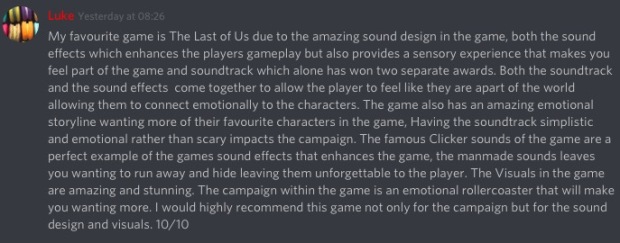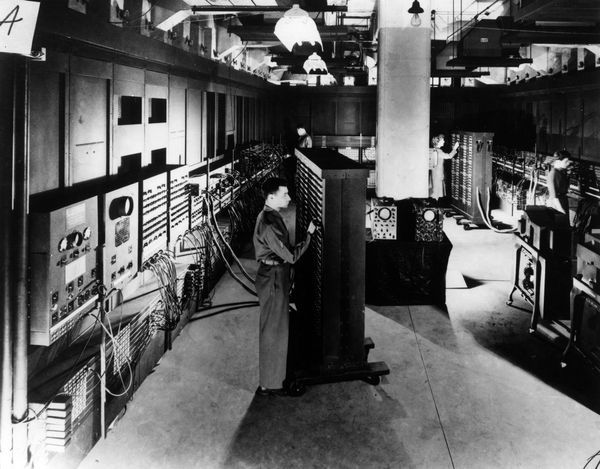Since I have covered the popular culture of each decade from the 1970’s up to the early 2000’s as well as the videogames present during the same decades, I now must discuss the culture of the present day. In order to format this information, me and the classmates I was working with for this task created a Powerpoint presentation
Category: Units 2 – 3
Unit 2 – Research
Social Media Task
As part of developing my research skills, I must ask friends on social media their opinions on certain topics. One of these topics is favourite games, where I must make a post on a social media platform asking my friends what their favourite game is and why. It is important to consider both the pros and cons when doing something like this so that I can weigh up how reliable of a form of research it is. Here are screenshots of the responses I got from my Discord server I created for this:



Advantages:
The advantages to this task were that it was easy to facilitate and relatively low effort. All I had to do was put up a post. It also allowed me to get a variety of responses despite the age group being the same amongst all of us.
Disadvantages:
The biggest disadvantage was the lack of responses. To give a bit of perspective, 7 people were invited, 6 joined, and these 3 are the only responses. That is 4 people who could have given their opinions but for one reason or another didn’t.
Unit 2 – Culture History
As part of Unit 2 of my course, it is essential that i have an understanding of the culture that was embedded in each decade from the 1940’s and 1950’s (which was covered in my “History of Videogames” blog post) up to the 1990’s.
1960’s
During the 1960’s, there were a number of films made that have become classics by today. Many of these films gave an outlook into what life was like during the decade which is why it is important that I research and look into some of these films. I have chosen 3 movies from the 1960’s to give a short summary of: “Kes”, “Cool Hand Luke” and “Psycho”
Kes – 1969
Directed by Ken Loach, this film follows Billy Casper, a 15 year old boy living in a working class family who suffers abuse from both his family and his peers at school. His only friend and escape is a Kestrel that he finds on a farm who he calls “Kes”. The both of them form a strong bond with each other to the disapproval of Billy’s family

Cool Hand Luke – 1967
Directed by Rosenberg, Cool Hand Luke tells the story of a man by the name of Luke Jackson who is sentenced 2 years in Florida prison farm. Unlike all the other inmates however, Luke doesn’t play by the rules, much to their respect. This includes constantly chastising the Warden and constant punishment as a result.

Psycho – 1960
Directed by Alfred Hitchcock, this psychological thriller takes place in the grim setting of the Bates Motel. When a woman is trying to escape the police she stops by the motel only to get stabbed to death in the shower. What follows is a number of murders that result in a satisfying conclusion.

1970’s
During the 1970’s there was a lot of diversity surrounding both American and British culture. This includes the hippie movement that began in the late 1960’s and made it’s was into the early 70’s as well. The hippies were protesting against the Vietnam war that was occurring at the time by spreading peace, love and smoking weed. A lot of this was influenced by the music of the time, with several bands like the Grateful Dead, Santana, The Doors and the Jimi Hendrix Experience with their unorthodox “psychedelic” sounds.
Progressing from this, a new genre of music called “Funk” emerged during the 70’s. This was prominently made by black musicians with groups like the Jackson Five and Chic who popularized dance and disco. Not everything was so glamorous however. Britain during the 70’s was a very different scene with the Punks and Mods who rebelled against the social conformities at the time, with bands like the Sex Pistols and the Who, both of which fueled this rebellion.
There were also several iconic films released during the 1970’s such as “Star Wars”, “The Exorcist” and “The Godfather”, however I have chosen the movie “Jaws” to focus on. Released in 1975 and directed by Steven Spielberg, “Jaws” follows a trio of protagonists whose goal is to put an end to several killings at the hand of a great white shark. There is the police chief Martin Body, the Ichthyologist Matt Hooper and the grizzled captain Quint. The film was so successful that it spawned a vast array of sequels and copy cat films including the more recent line of “Sharknado” films that parody Jaws in a comedic way. There hasn’t been a true remake to Jaws but the classic is fine on it’s own.

1990’s
British fashion in the 90’s was mainly dominated by tracksuits and branding. This includes Adidas which was endorsed by many celebrities including Run DMC. The fashion in America was much more vibrant and colourful which can be shown in TV shows like “Fresh Prince of Bel -Air”. The 1990’s also had a lot more variety when it came to the music. Britain had indie bands like the Stone Roses and Oasis, whilst also popularizing rave culture including artists like Prodigy.
In America however, there was a much heavier scene. Rock music was made up of grunge bands and metal heads like Nirvana and Metallica who exposed a darker sound to mainstream music whilst many other musicians created rap and hip hop. During the mid 90’s the west and east coasts of America were divided by hip hop’s 2 leading figures: Tupac and the Notorious BIG.
During the 90’s, one of the most popular film directors was Quentin Tarrantinto who’s distinct style came from his clever editing techniques and his fearless nature in regards to gruesome and explicit content in his movies. Movies like “Reservoir Dogs” (1992) and “Pulp Fiction” (1995) contained a number of scenes that were shocking for the time and have paved the way for how violence in movies is portrayed these days.


Unit 2 – History of Videogames
For Unit 2 of my course “Game Arts & Concepts”, it is important that I have an understanding of the history of videogames in order due to the importance of its fast progression. Video games as a medium has evolved faster than other forms of entertainment like Movies and TV so each decade has been documented below from the beginning of computers all the way up to the new millennium.
Week 1 – 1940’s/1960’s
In the beginning, computers were created out of necessity due to the Germans’ Enigma code during World War II in the mid 40’s. Alan Turing, a skilled computer scientist, was appointed by the British Government to create his own computer which would crack the Enigma code. Many comparisons have been drawn between Alan Turing’s suicide and Apple’s company logo due to the fact that Turing died by eating a cyanide laced apple. It is thought that the logo is paying tribute to Alan’s work as Apple manufacture computers.
Back in the 1940’s, computers were very different to how they are now. The ENIAC (Electronic Numerical Integrator And Computer) for example, weighed 30 tons, contained 19,000 vacuum tubes, necessitated 6000 switches and was capable of adding 5000 numbers in a second. This was a remarkable accomplishment at the time and it was for strict military use only. Here is a photo:

Once the war had ended, the computers had no further military use so computer scientists decided to reprogram them and make their very own computer games. One of the very first computer games was “Tennis for Two” in 1958. As the name implies, it was a very basic 2 player tennis simulation which was made using a oscilloscope for the screen. Here is a photo:

Following on from this, Steve Russell developed a game called “Spacewar” in 1962 which was released to the public, unlike Tennis for Two. Here is a screenshot:

Week 2 – 1970’s
By the 1970’s, electronic videogames were beginning to become very commercially successful. They were no longer exclusive for military use and could be easily sold to the general public. While they might look primitive and basic by today’s standards, back then these games were groundbreaking and immensely popular.
During the 1970s, games were played on arcade cabinets that were coin operated – meaning they required a coin to be inserted into the machine in order to let the player access the game. In order to capitalise on this mechanic, most developers made sure that their games were challenging and addictive so that gamers would keep on playing. They were also pretty big (around the size of a fridge) and required you to stand up while playing.
Not all games around this time were found at arcades however. Their were also a number of games that could be played on computers such as “Maze War” which was available for the Xerox Alto. Much like the arcades machines, these games are very primitive for today’s standards but are still fun none the less. Notable games that came out in the 1970s would be “Pong”, “Breakout”, “Space Invaders” and “Galaxian”. Here are some screenshots of each:
Week 3 – 1980’s
In the 1980s, game companies continued to produce arcade cabinets that were met with massive popularity, mainly from Japanese companies such as “Pac-Man” (1980) by Namco and “Donkey Kong” (1981) from Nintendo. As well as this however, American company Atari released their own home game console known as the Atari 2600 which had a catalogue of videogames varying in quality. Some were good, but most were pretty bad.
In fact, the games on Atari were so bad that they were responsible in part for the Videogame crash of 1983. This was a point in which the games industry was deteriorating due to the huge losses in money from Atari which was a result of their low quality games. One of the most notable examples would be the game “E.T.” (1982) which lost so much money, the cartridges had to be buried in the desert.

The games industry was in a downward spiral and the state in which it was in looked so bleak that it was uncertain whether or not games would still be around for much longer. Until that is Nintendo brought their Famicom console over to the west which was localised as the NES (Nintendo Entertainment System). The quality of the games were a huge step up from Atari’s with classics like “Super Mario Bros.” (1985) and “The Legend of Zelda” (1986) which single-handedly saved the gaming industry.
Week 4 – 1990’s
By the 1990’s, Nintendo were so popular that Atari had essentially faded into obscurity. Nintendo’s popularity subsequently inspired competition in the form of SEGA who combated the Super Mario games with their own “Sonic the Hedgehog” (1991) line of games on the SEGA Mega Drive. At the same time, the arcade games were getting better and better, for example “Street Fighter II” (1991) by Capcom who are another Japanese developer.
Most games up to this point however were made in 2D, and the 90’s saw the introduction of games in 3 Dimensional space. The main 2 consoles competing during the late 90’s were the Nintendo 64 and PlayStation, with PC games still going strong. Notable games from this era would be “Super Mario 64” (1996), “Goldeneye 007” (1996) by Rare, “Tomb Raider” (1996) by Eidos,”Grand Theft Auto” (1997) by Rockstar, “The Legend of Zelda: Ocarina of Time” (1998), and “Metal Gear Solid” (1998) by Konami. These were all very popular and revolutionised the way games are made.
Week 5 – 2000’s
By the time the 2000’s came along, it was the norm to use 3D graphics to create games and 2D games were virtually non existent (except for a few titles, mainly from the indie market). It was also a time in which there was an abundance of first person shooter games such as “Halo: Combat Evolved” (2001) by Bungie for the XBOX, “Call of Duty: Modern Warfare” (2007) by Activision for a variety of platforms and “Portal” (2007) by Valve despite it being more puzzle based. As well as this, the best selling video game console to date, the Playstation 2, was released with many games alongside it. One notable game would be “God of War” (2005) by Sony which is a fighting/adventure game amidst all the first person shooters that filled the market.
As well as this, the 2000’s saw the introduction of motion controls with the Wii from Nintendo in which the controller is waved, shook, waggled and pointed as forms of input. Significant games from this console that take advantage of this mechanic would be “The Legend of Zelda: Twilight Princess” (2006) and “Super Mario Galaxy” (2007), both of which were developed by Nintendo.
Apart from the current decade of the 2010’s, I have covered a good bit of the history of Electronic Videogames. However, this has merely scratched the surface on the huge landscape that is videogames. There are plenty of games, consoles, companies and significant moments in history that I have not outlined on this Blog post simply because it would take up too much time. However, I have shown my understanding of how games as an art form have evolved greatly since the days of “Tennis for Two” all the way up to a Triple-A big budget franchise like “Call of Duty”. To conclude this, I have below a comparison between 2 games in order to visually illustrate this progression:








































